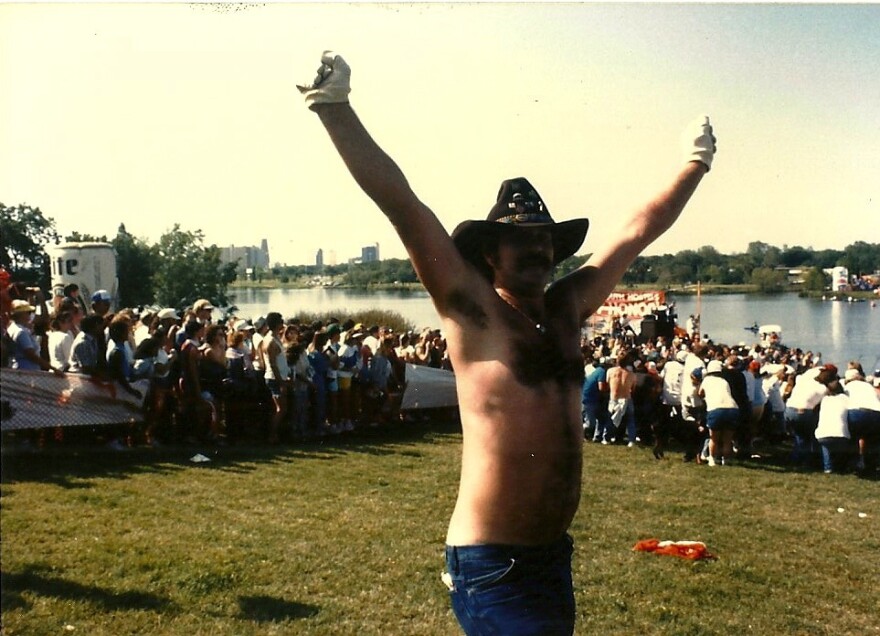This piece was originally produced for ATXplained Live in January 2020.
Austin has had its rivalries. In the '60s and '70s, it was the Hicks versus the Hippies. Nowadays, maybe it's the people who live here now versus the people on their way.
In the 1980s, it was Yuppies versus Bubbas. North Side versus South. People looked down their noses at each other from across the river. Even Austin’s acclaimed writers of the time got in on the act.
“You know if you want to get an education go to the North Side,” wrote columnist and author Molly Ivins. “If you want to get your furniture reupholstered, go to the South Side.”

Austin American-Statesman humor columnist John Kelso fed the flames.
“South Austin is so far superior to any place north of the Colorado [River] that North Austin just plain old pales when the two are compared,” he wrote. “In South Austin society, things are much less confusing, much simpler. This is because all the men in South Austin, as well as their dogs, have the same name, Bubba.”
Austin was a different place back then. MoPac stopped at 360 and 183 was not a freeway. There were only two Chuy’s, one Amy’s, and no scooters. Barton Springs was cleaner, rents were cheaper and the music was so much better than whenever you moved to town.
Lin Zagorski grew up hearing from her father about a fabled battle between North and South Austin. She wanted to know if there was ever a tug-of-war between North and South Austinites on the Congress Bridge in the 1980s. So she asked for our ATXplained project.
The simple answer is: No. There was not a tug-of-war across the Congress Bridge.
It was held across Town Lake (now Lady Bird Lake) on the East Side of I-35.
You want to do what?
The event was the brainchild of Charlie Gandy, who currently does bicycle and pedestrian advocacy and consulting in Seattle. "And [I] smoke a little weed.”

Before you dismiss him as some hippie ne’er-do-well — Gandy was a state legislator, a Democrat from Mesquite. He was also a staff member for then-Gov. Mark White and an advocate for youth hostels. He spent some of his youth running around other countries staying in hostels and wanted to bring one here.
The problem was, American Youth Hostels had no interest in Austin. It was worried no one wanted to come here. So Gandy and his committee would have to figure out how to fund one themselves.
“We started looking at different ways to raise money, and having gone to college here, every weekend there was another bicycle ride or run,” he says. “10Ks were popular then and century rides, and I said, ‘We don’t need to compete against that. Let’s do something different.'”
“Something different” became stringing a rope from one side of Town Lake to the other.
“Have a tug-of-war, North versus South Austin, Bubbas versus Yuppies,” Gandy says.
The response, he says, was: ‘What are you smoking now?'”
It was a great idea, but there were logistical challenges.

“Well, we didn’t have a rope,” he says, laughing. “We didn’t have an engineer."
Gandy was thinking big. Bigger than anything that had ever been done before. He wanted the Guinness World Record: 500 Yuppies on the North shore and 500 Bubbas on the South. A thousand people jerking on a rope configuration across Town Lake.
“We wanted the recognition from Guinness,” he says. “I check in with Guinness and they said, ‘We don’t do tug-of-wars.’ And I said, ‘Why?’ And they said, ‘Well, it’s too dangerous. People get killed doing this stuff. You build up a lot of energy in that rope.’ And that was news to us.”
So, in the middle of putting together this Tug of Honor, what could be the most storied fundraiser in Austin’s history, Gandy and his committee realized people could die or get severely hurt.
The perils of pulling rope
The tug-of-war seems benign. It’s a staple of elementary school field days. Colleges, like Harvard, once had tug-of-war teams. It was even an Olympic sport from 1900 to 1920. The U.S. medaled five times.
But these are in fairly controlled settings where the force generated does not exceed the rope’s capacity to sustain it.

During a tug-of-war, the rope stretches like a rubber band. When rubber bands break in your hand, it stings for a second. Now imagine a rubber band pulled by hundreds of people, with tons of pressure stored in it.
In 1995, German Boy Scouts were trying to set what they believed to be a world record. The rope snapped and killed two boys. Just five days before that incident, a Tennessee man lost a hand after wrapping the rope once around his wrist. In Taipei in 1997, a mass tug-of-war exerted three times the amount of pressure the nylon rope was designed to withstand. It ended with the rope breaking and severing the left arms of two men.
Accountant Richard Viktorin was helping the fundraising efforts by monitoring the bottom line. He could only guess a similar catastrophe at Town Lake would sink the youth hostel efforts. They had to find someone who could make it safe — or at least safer.
Gandy tapped an engineer named Don Garner, who designed a rig that would allow the Bubbas and the Yuppies to safely pull each other into the lake. To minimize the stretch, he put seven thick 200-foot polypropylene ropes on each side. Those ropes were attached to two steel I-beams. The heavy beams floated on foam across the lake from each other and were attached by two stranded metal cables.
Showtime!
With safety concerns behind him, Grandy did his best P.T. Barnum and pumped up the event. He reached out to Kelso at the Statesman. They were friendly and his columns were a big deal.
“I said, ‘We want to do a Tug of Honor, and I want you to coach the Southside team. And we want [former UT football coach] Darrell Royal to be the coach of the Northside team,’” Gandy said. “And Kelso thought about it for about 30 seconds and said, ‘OK, let’s go.’”
Kelso was critical to the tug-of-war’s success. For years, he used his humor column to dive into the differences between North and South Austin. He usually painted North Austinites as erudite, hoity-toity and highfalutin; South Austinites were simple — in a good way.
Judging from the pictures of the event, though, it was hard to tell who was on which side.

Gandy and Kelso played up those differences in preparing for the event.
“We were going to have Bubbas on the South with beer and barbecue and a band,” Gandy said. “On the Northside, for the Yuppies, we were going to have a band also, but we were going to have wine and quiche, and all the signs were going to be in French.”
Gandy would keep track of contestants’ cumulative weight. To boost participation, he would update Kelso how far behind one side was from the other in tonnage. The South Side always seemed to weigh more.
Ever the promoter, Gandy promised music and alcohol, and morning deejays provided play-by-play. There were weird feats of strength and “cheerleaders” from a local gentlemen’s club. Participants paid $20 to be part of what might have been the largest tug-of-war ever — if it could be designated as such. All the money benefited the hostel.
The tug-of-war was considered over when the first 200 people were pulled into the water. There would be a brief rest and then another tug. The first side to win two pulls got bragging rights for the year.
Every year a pattern held. The South won the first pull. The North won the second. Then the South would win the third and deciding tug.

Victim of its own success
The event far exceeded Gandy’s expectations. The organizers were able to get exactly what they needed for a hostel in just three years, so they ended the Tug of Honor.
Viktorin says it was amazing they were able to pull it off.
“You gotta understand, at the time, those years — in ‘86, ‘87, ‘88 — Austin was in something that no one can conceive these days: a recession,” he says. “A genuine recession where people didn’t have jobs. People left this market to go to Houston and Dallas. So, that probably elevated how the event stood out in the community a little bit more.”
The recession helped propel the committee’s earnings. Gandy and others used the proceeds to bid the minimum for a bunch of foreclosed properties across the state. The nonprofit later sold those for half a million dollars. Some of that money is still being used for Austin Youth Hostel’s endowment today.
It would be hard to pull off such an event these days, with permitting costs, fencing, security concerns, etc.
The organizers were young and didn’t know any better. No one died or was maimed. They raised a ton of money.
And they created yet another great story of what Austin used to be.












